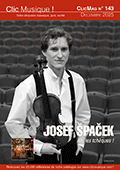 Quel intéressant programme que les six compositions assemblées sur ce disque, auxquelles Lukas Huisman donne vie d’un doigté combattif et maîtrisé – Ivo Delaere, un autres des élèves de Daan Vandewalle à la Faculté de Musique de Gand, ajoute sa propre habileté pour l’interprétation de "Shikkun", pour piano à quatre mains, pièce écrite par un Keitaro Takahashi (1986-) subjugué par le défilé de senteurs ressenti en parcourant à moto les montagnes japonaises (certes, c’est le deux-roues qui bouge, pas les parfums). "Furin", carillon éolien traditionnel destiné relier ses sons doux à la fraîcheur d’été, dévoile toutefois des passages fièrement percussifs, tandis que "Ryouka", lui aussi composé pour piano préparé, parle de la richesse de l’écho des imposantes crêtes des montagnes Tateyama. Plus ancien d’une génération, Akira Nishimura (1953-), nourri à la fois des techniques de composition occidentales et d’un goût pour les musiques traditionnelles asiatiques présente, avec "Mirror of Star", une délicate interprétation du scintillement stellaire et, avec "Three Visions", en trois mouvements, un point de vue, rude et vigoureux – "Flame" ne requiert que les dix touches les plus graves de l’instrument –, inspiré de son voyage à Benares, un des lieux les plus sacrés en Inde : on y retrouve la technique de l’hétérophonie, qui présente simultanément des variations de la même mélodie. (Bernard Vincken)  Two major contemporary Japanese composers, writing for the piano with vivid imagery and brightly piercing harmony. Born in Osaka in 1953, Akira Nishimura is one of Japan’s most distinguished living composers, extensively performed and recorded, though many of those albums are unavailable internationally. He has contributed to all the major classical genres including opera. There is a slow but irresistible momentum to the pull of his harmony in most of his orchestral works which is shared by the trio of pieces recorded by Lucas Huisman. Nishimura’s Mirror of Star (1992) is a musical picture of the night sky which imbues the melody line with subtle echo effects, like a halo of reverberation: ‘calm on the surface but obsessional anxiety deeper down,’ according to the composer. Two years later, he completed a set of three Visions for piano, titled of Aqua, Flame, and Invoker. Flame uses only the bottom ten notes of the piano, glowing with overtones like Mirror of Star. Aqua is inspired by the river Ganges and the rituals of burial which take place on its waters, while Invoker is a prayer using the technique of heterophony which overlays subtly different versions of the same melody. Finally, from 1987, Carillons of Ekstasis also makes extensive use of the piano’s lower register as well as the top octave to evoke the starry heavens and the gap between them and us. Born in 1986, Keitaro Takahashi has studied and worked in both his native Japan and in Europe (especially Switzerland), and his music fulfils an ambition to integrate those disparate cultures by employing instrumental, electronic, or environmental sounds according to East Asian philosophies and concepts. Furin evokes a traditional Japanese wind chime made of glass or pottery in a sound portrait of a Japanese summer which is gently distanced by preparing the piano with rubber tuning mutes. From 2014, Ryouka also uses a prepared piano in a tone portrait of the towering mountain ridges of the Tateyama range and in particular a painting of them by the Hiroshima-born artist Genso Okuda. Shikkun (2018, rev 2022) is scored for piano four hands; like Ryouka, the title is a neologism coined by Takahashi to describe a state of simultaneous motion and stillness which he came up with on a mountain bike-ride in Japan.
 |
